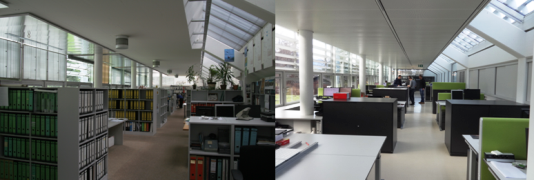

IEA SHC Task 50: LightingRetrofitAdviser.com for Investors and Planners
 A redesign of lighting systems in office or public buildings helps to save electricity and improve lighting quality, as the office building of the Austrian company Bartenbach on the photos shows. However, lighting systems are rarely upgraded: For example, in Germany, retrofits can only be found in 3 % of the existing building stock and 75 % of lighting systems are out of date, as they are older than 25 years. To support planners and investors in their decision on what would be the most apt lighting retrofit, the researchers of Task 50 of the IEA Solar Heating and Cooling Programme, Advanced Lighting Solutions for Retrofitting Buildings, have launched a website called http://www.lightingretrofitadviser.com and an app for Android and iOS devices. Both provide stakeholders with information about successful case studies of lighting retrofits in buildings, a database of technologies as well as tools, for example, to give direct onsite support for decision making, whether it is sensible to retrofit a lighting system. A webinar on 21 March explained all the services and features of the new website and app. A recording of it is available online.
A redesign of lighting systems in office or public buildings helps to save electricity and improve lighting quality, as the office building of the Austrian company Bartenbach on the photos shows. However, lighting systems are rarely upgraded: For example, in Germany, retrofits can only be found in 3 % of the existing building stock and 75 % of lighting systems are out of date, as they are older than 25 years. To support planners and investors in their decision on what would be the most apt lighting retrofit, the researchers of Task 50 of the IEA Solar Heating and Cooling Programme, Advanced Lighting Solutions for Retrofitting Buildings, have launched a website called http://www.lightingretrofitadviser.com and an app for Android and iOS devices. Both provide stakeholders with information about successful case studies of lighting retrofits in buildings, a database of technologies as well as tools, for example, to give direct onsite support for decision making, whether it is sensible to retrofit a lighting system. A webinar on 21 March explained all the services and features of the new website and app. A recording of it is available online.Photos: Bartenbach
Technology viewer: Thirty-eight lighting retrofit solutions under evaluation

“Replacing a lamp or adding blinds to windows are widely accepted and cost-effective measures,” Martine Knoop, Lecturer at the TU Berlin, Germany, explained during the webinar. “But we also know that more labour- or capital-intensive solutions, such as replacing the surface reflectances, changing the focus of illumination to where you need it, or removing interior walls can improve the quality of lighting solutions.” To provide investors with a quick overview of retrofit technologies which would best meet their requirements, Knoop and her team have set up an online database with 38 fairly different electric and daylight retrofit solutions. All of them were thoroughly evaluated based on several criteria. The yellow bar below the 3D models (see screen shot above) stands for Energy Efficiency, the blue one for Lighting Quality and the red bar for Thermal Aspects (impact on heating and cooling loads). Each solution was compared to conditions in a benchmark room (vertical grey line). When clicking on a product, a user will also receive an assessment of running and initial costs and be shown the type of intervention (from simple upgrade to labour-intensive redesign).
Case study reviewer: 20+ retrofits show significant saving

Investors can use the case study viewer to look at 20 reference buildings, including a before-and-after comparison. The viewer’s key feature is the cost analysis of the measures which were implemented. On average, the saving lowered electricity demand from 17.1 kWh/m² to 14.3 kWh/m². The top-ranked project – a halogen lamp installation in the lobby on the ground floor of the Lozenberg office building in Brussels, Belgium – even reduced electricity demand by more than 80 %.
On site Optimizer: Compare retrofit designs within seconds

Designers and planners can use the online overview to see what calculation tools they have at their disposal. An important new service for planners is the On Site Optimizer, an app which allows planners to analyse rooms based on a variety of options and instantly compare the benefits each solution offers for optimising and retrofitting the lights in these rooms.
Additionally, the researchers worked on speeding up the calculation of daylight solutions. “Prior to our project, it took basically hours to evaluate the impact of an advanced daylight solution on annual energy demand,” explained Dr Jan de Boer, Operating Agent of Task 50 and Group Manager Lighting Technology and Passive Solar Systems at the Efficiency and Indoor Climate department of the Fraunhofer Institute for Building Physics in Stuttgart, Germany. One key outcome of the research efforts has been the CFS Express Tool (CFS = Complex Fenestration System), which allows for a performance analysis of complex fenestration systems on web-connected devices in fewer than five seconds.
Advanced Lighting Solutions for Retrofitting Buildings was the first of a series of webinars organised by the IEA SHC Programme’s Solar Academy and hosted by the International Solar Energy Society. The second webinar on Industrial Solar Heat will take place on 28 June 2016 (the exact time will be announced soon). The webinars are one of four ways in which the IEA SHC is reaching out to a global audience to exchange information and to support R&D efforts and the implementation of solar heating and cooling projects all over the world. For more information on other Solar Academy activities, please go to: https://www.iea-shc.org/solar-academy
More information: